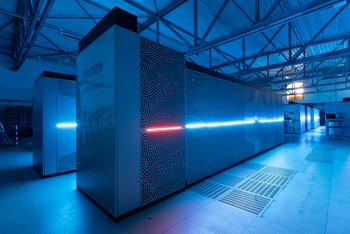MPI-M to be one of the first users of Europe's fastest supercomputer JUPITER

This spring, Europe's fastest supercomputer, JUPITER, is going into operation – and the Max Planck Institute for Meteorology (MPI-M) will be one of the first users of this extraordinary infrastructure. A corresponding proposal to the Gauss Supercomputing Centre, which MPI-M researchers led by group leader Daniel Klocke submitted together with partners from the German Climate Computing Center (DKRZ) and the Jülich Supercomputing Centre, has now been approved. The proposed climate simulations are thus one of several lighthouse projects on JUPITER that are of high societal relevance and are intended to pave the way for a new era of European High Performance Computing. As part of the JUPITER Research and Early Access Program, the involved partners had previously shown that their project not only benefits greatly from the extraordinary computing capacities, but also that the ICON Earth system model used for this purpose can use the resources efficiently.
From May 2025, the researchers will simulate the Earth's climate for the first time with a resolution of just one kilometer for an entire year – taking into account all the important Earth system components that describe the climate system. In addition to the atmosphere, the ocean, the land, and sea ice, this also comprises the simulation of the entire carbon cycle, including the transport of carbon dioxide. "This is a big step for us and has not been possible until now," says Daniel Klocke.
Making efficient use of Europe's fastest computer
With more than one quintillion – i.e. 1,000,000,000,000,000,000 – floating point operations per second (FLOPS), the high-performance computer installed at Forschungszentrum Jülich will be the first so-called exascale computer on the European continent. For comparison: an average laptop achieves several hundred billion FLOPS – JUPITER's performance is therefore equivalent to that of a few million laptops. Even the Finnish supercomputer LUMI – on which the MPI-M and its partners in the "Destination Earth" project carry out complex calculations with high-resolution models – "only" achieves 380 quadrillion FLOPS – a good third of what JUPITER can be expected to achieve.
Being able to perform calculations on such systems is a privilege – and a challenge. The fastest computers in the world use graphics processing units (GPUs) instead of the conventional central processing units (CPUs). In order for a computer model to be able to use these, the algorithms must be adapted. Scientists at the MPI-M, the CSCS Swiss National Supercomputing Center and other partners have been developing the ICON Earth system model accordingly for years. The team will continue to work on the code to configure and optimize the simulations until the start of the computing period on 1 May.
Investigating regional climate impacts
By the end of October, the scientists expect to have completed the high-resolution simulations over an entire seasonal cycle. These will be used to investigate phenomena that occur on very different spatial scales and yet interact. For example, the researchers want to clarify how storms influence global wind systems and the global carbon cycle. Answering such questions should help to better assess the regional consequences of climate change.
Further information
Model infrastructure at the MPI-M
Applications for JUPITER on the FZ Jülich website
Contact
Dr. Daniel Klocke
Max Planck Institute for Meteorology
daniel.klocke@mpimet.mpg.de
Dr. Cathy Hohenegger
Max Planck Institute for Meteorology
cathy.hohenegger@mpimet.mpg.de
Dr. René Redler
Max Planck Institute for Meteorology
rene.redler@mpimet.mpg.de
